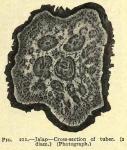The dried tuberous root of Exogo'nium pur'ga (Wenderoth) Bentham, yielding, by assay, not less than 7 per cent. of resin.
BOTANICAL CHARACTERISTICS.—Stem brownish, smooth. Leaves long-petiolate, cordate-ovate, acuminate, entire, smooth. Peduncles axillary, 2-flowered; corolla crimson or light red, four times the length of the calyx.
HABITAT.—Mexico; now successfully cultivated in India.

 DESCRIPTION OF DRUG.—A compact, heavy, hard, pear-shaped tuber, varying in size, but never larger than the fist; the larger ones are longitudinally incised to facilitate the drying, which is done over the hearths of the Indian huts, hence externally brown, smoky, more or less wrinkled, covered with thick, round warts of a somewhat lighter color; internally gray to dark brown; fracture horny and resinous; odor peculiar, smoky, partly due to the manner of drying; taste starchy, afterward slightly acrid. Powdered jalap is yellowish-gray, and when inhaled causes sneezing and coughing.
DESCRIPTION OF DRUG.—A compact, heavy, hard, pear-shaped tuber, varying in size, but never larger than the fist; the larger ones are longitudinally incised to facilitate the drying, which is done over the hearths of the Indian huts, hence externally brown, smoky, more or less wrinkled, covered with thick, round warts of a somewhat lighter color; internally gray to dark brown; fracture horny and resinous; odor peculiar, smoky, partly due to the manner of drying; taste starchy, afterward slightly acrid. Powdered jalap is yellowish-gray, and when inhaled causes sneezing and coughing.
STRUCTURE.—Cortical layer thin, with a dense circle of resin cells near the cambium line; interior composed chiefly of parenchymatous tissue containing starch and calcium oxalate, arranged in which are concentric zones of resin cells, the broader, darker, alternate zones being formed by a closer packing of the cells; medullary rays small, but plainly visible. The false jalaps which frequently adulterate the drug in market may usually be detected by the difference in internal structure.
ADULTERATIONS.—Immature roots, roots partially deprived of resin by treatment with alcohol. These are sticky, internally darker than the genuine and other species of Ipomcea.
 Powder.—Characteristic elements: See Part iv, Chap. I, B.
Powder.—Characteristic elements: See Part iv, Chap. I, B.
CONSTITUENTS.—Besides starch, calcium oxalate, etc., jalap contains a resinous substance which consists of two portions, a soft resin, jalapin, soluble in ether, and a hard resin, constituting nine-tenths of the mixture, termed jalapurgin or convolvulin (a glucoside, C31H50O16); this latter is supposed to be the active principle. The U.S. Pharmacopoeia (IX) has fixed the lowest limit of resin at 7 per cent. (which includes both resins).
The varying strength in jalap may be accounted for by the fact that the roots are dug at all seasons of the year. In the fall, when the aerial stem has decayed, it is better than in the spring, at the sprouting season. Ash, not to exceed 6-5 per cent.
ACTION AND USES.—Hydragogue cathartic, generally used in dropsy in the compound powder of jalap. Dose: 15 to 30 gr. (1 to 2 Gm.).
- OFFICIAL PREPARATIONS.
- Pulvis Jalapae Compositus (35 per cent. with potassium bitartrate) Dose; 15 to 60 gr. (1 to 4 Gm.).
- Resina Jalapae 2 to 5 gr. (0.13 to 0.3 Gm.).
- Pilulae Catharticae Compositae 2 to 5 pills.
461a. IPOMOEA PANDURATA.—WILD JALAP. MAN-ROOT. MAN OF THE EARTH. The root of Ipomoe'a pandura'ta Meyer. Occasionally met with in commerce, in the form of longitudinal slices with an irregularly wrinkled, brownish-gray bark overlapping the white wood. The woody center is divided into narrow wood-wedges by medullary rays dotted with resin cells. Nearly inodorous; taste sweetish and bitter. Contains panaquilon (the sweet principle found in panax), mucilage, starch, resin, etc. Diuretic and cathartic. Dose: 15 to 60 gr. (1 to 4 Gm.).
461b. FALSE JALAPS.—Ipomoea simulans (Tampico jalap), a somewhat globular root yielding a resin (tampicin), very similar to jalapin, nearly soluble in ether. I. orizabensis (fusiform or male jalap), a spindle-shaped, large, woody root, often in sections, the resin orizabin (unfortunately named jalapin) entirely soluble in ether.

